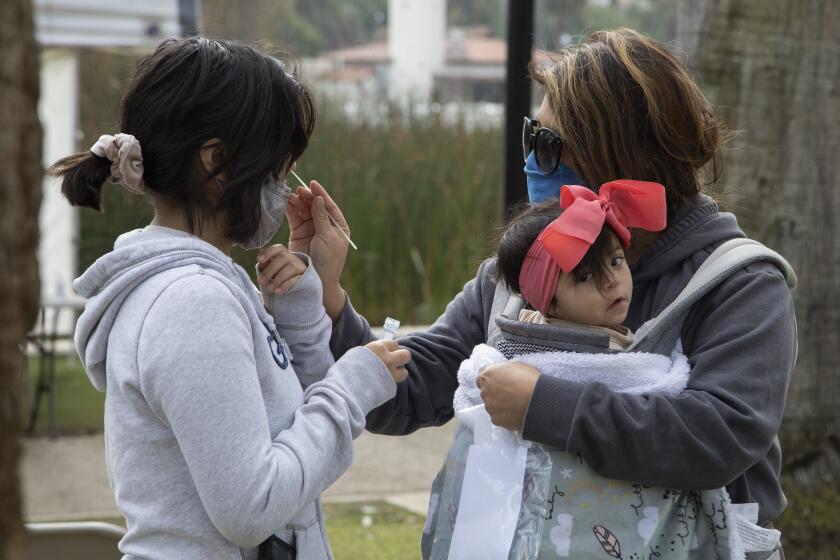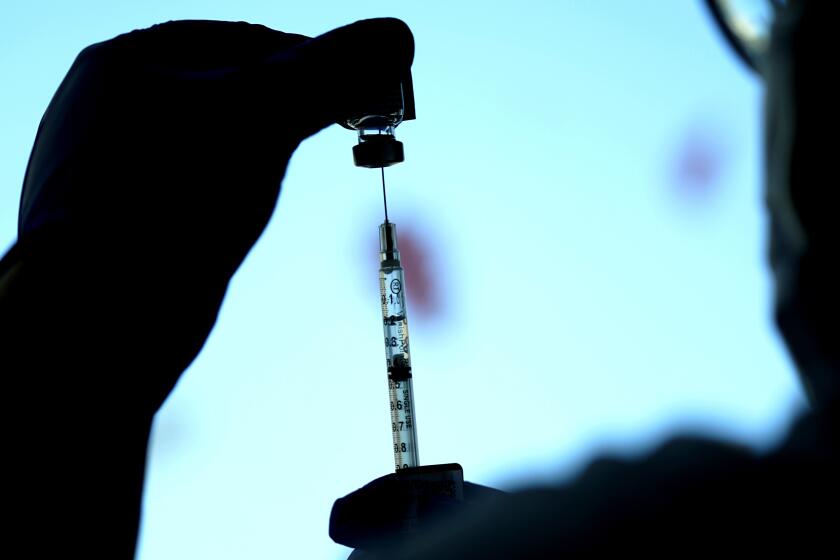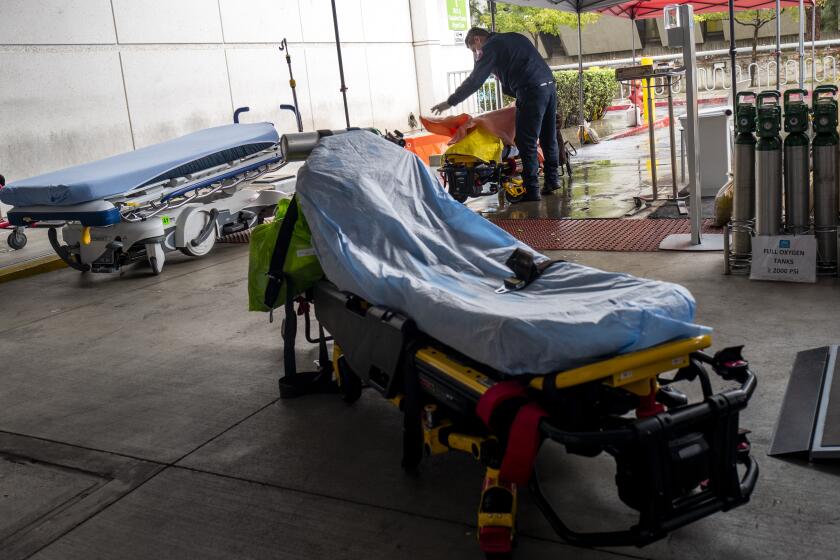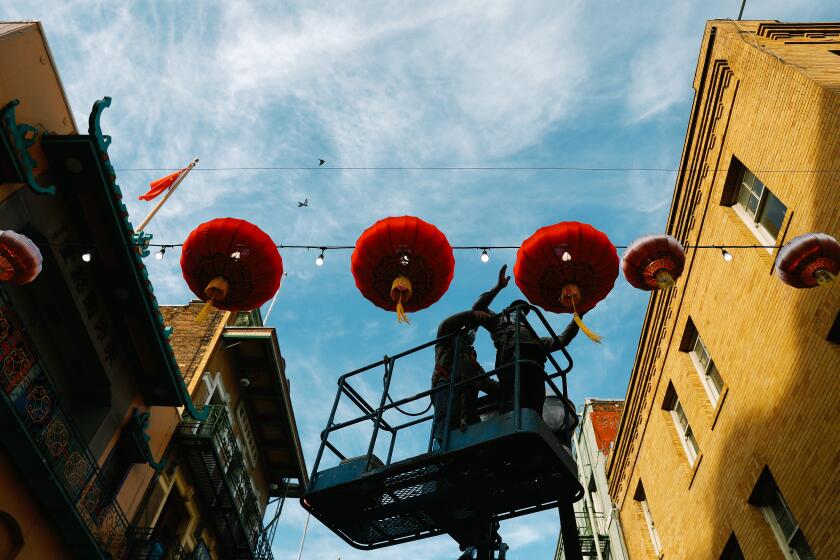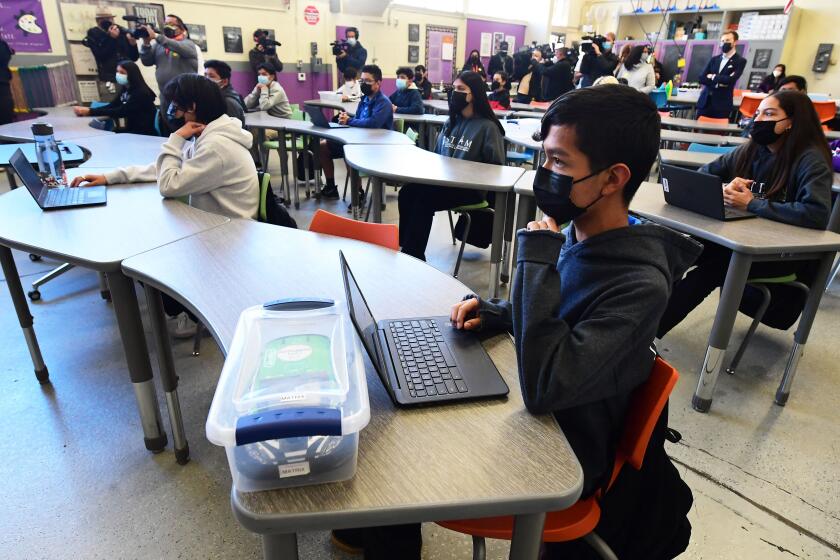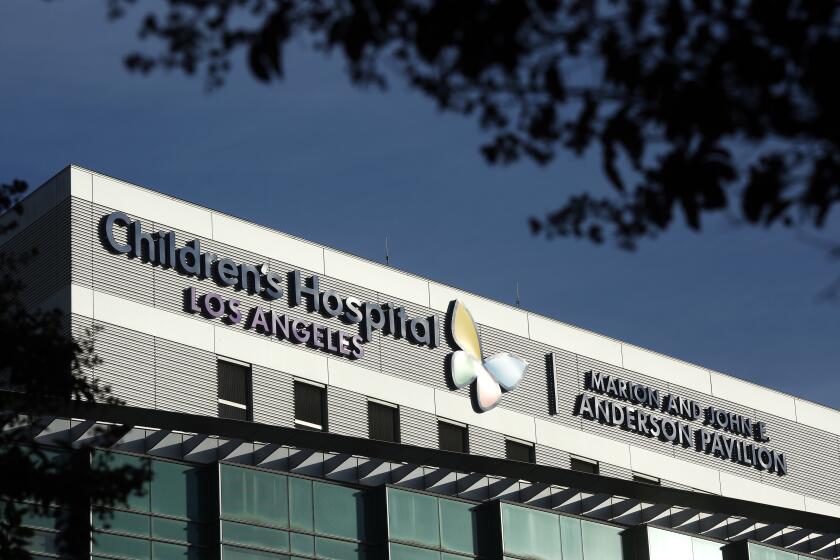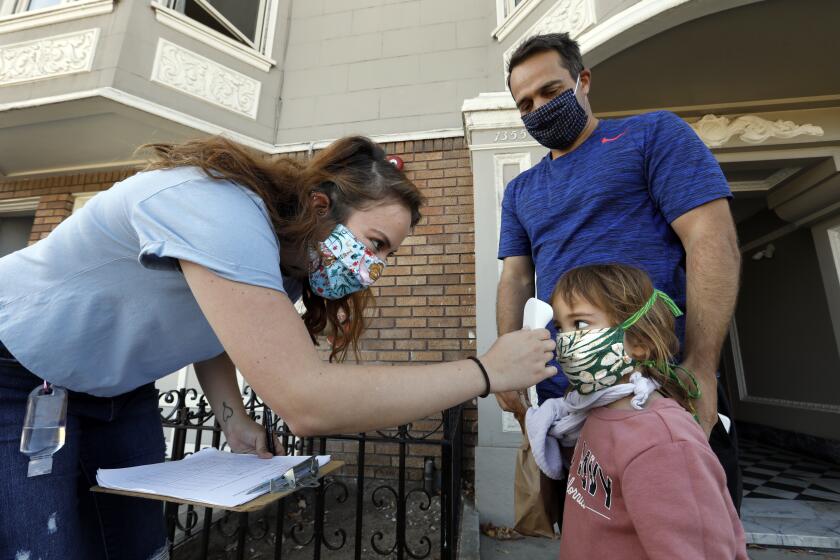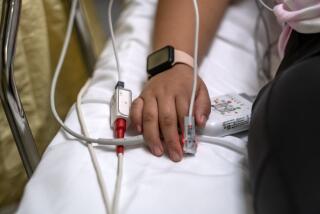Even as Omicron plateaus, L.A. County officials recommend avoiding gatherings
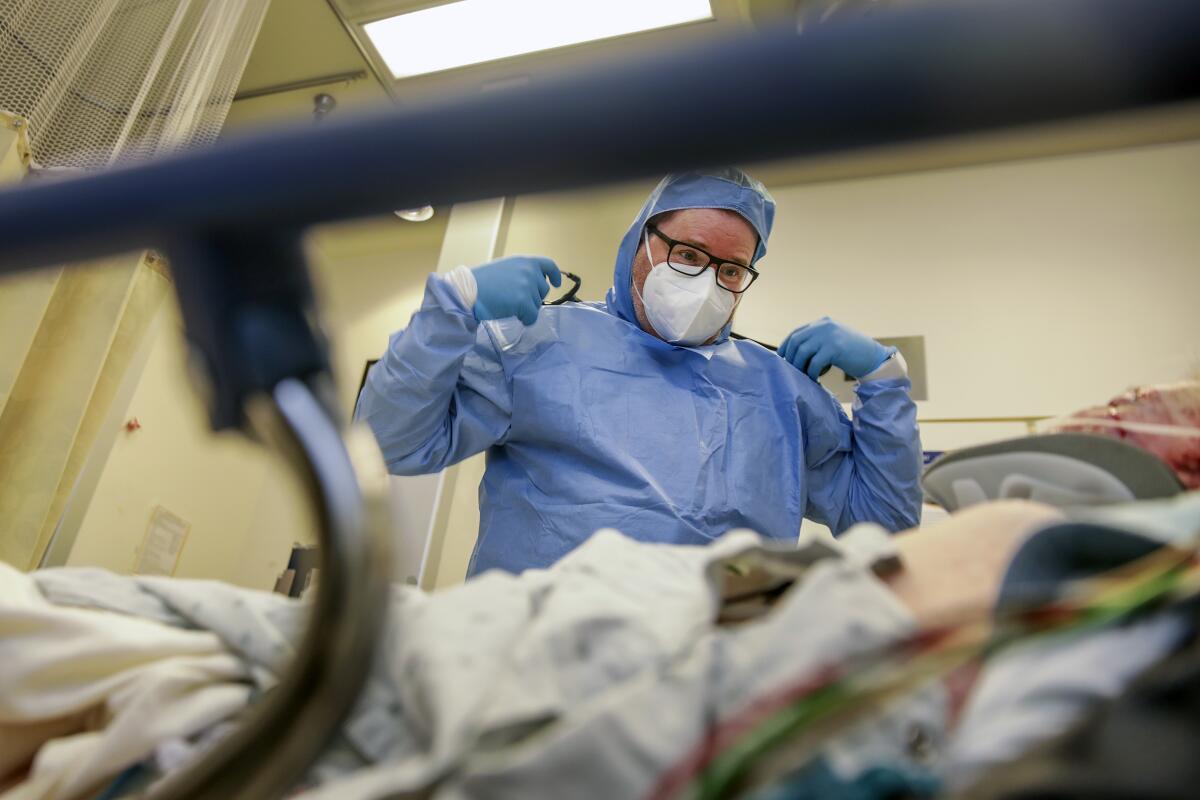
Even as the winter Omicron surge flattens, Los Angeles County health officials are urging the public to continue avoiding nonessential gatherings, saying coronavirus transmission remains at one of the highest levels ever seen in the 2-year-old pandemic’s history.
Despite recent declines, California is averaging over 100,000 newly reported coronavirus cases a day — more than twice as high as last winter’s peak of 46,000. The latest figure represents an extraordinary level of transmission that demonstrates how many more people are simultaneously infected and contagious than at any previous point of the pandemic.
So even as officials express hope that California’s winter surge is finally cresting, and in some areas, starting to decline, Los Angeles County Public Health Director Barbara Ferrer said it’s still wise to postpone nonessential activities where people are unmasked and in close contact with others, like dinners and parties.
“We need to be extraordinarily cautious when there’s this much community transmission. We’ve actually never had this much community transmission at any other point during the pandemic,” Ferrer said. “It’s extraordinarily easy to be exposed. And for some people, when they are exposed, they can go ahead and become infected, and a small number of those people are in our hospital right now fighting for their lives.”
The rapid spread of the coronavirus appears to be decelerating, another indication the state is on the downslope of the Omicron spike
L.A. County on Thursday reported 102 new COVID-19 deaths, the highest single day total since March 10, 2021. Weekly COVID-19 death rates have doubled in recent weeks in both the county and the state as a whole — though they remain less than one-quarter of those seen during last winter’s worst moment, likely on account of decent levels of immunity due to vaccinations and past viral exposure.
Hospitalizations have also risen dramatically during the Omicron wave. The overall number of coronavirus-positive patients in the hospital in California climbed 15% in the last week, reaching 15,383 on Thursday. Of those patients, 2,485 are in intensive care units, a figure that climbed 21% in the last seven days.
However, the statewide number of such hospitalizations ticked down ever-so-slightly from Wednesday to Thursday, dropping by 10 patients.
The downtick, though slight, follows a roughly month-long spike during which California’s coronavirus-positive hospital patient count more than quadrupled.
Some of the state’s most-populous counties — including L.A., San Diego, San Bernardino, Orange and Riverside — also recorded slight day-over-day decreases in their patient counts.
Three U.S. studies offer more evidence that the COVID-19 vaccines are standing up to the Omicron variant, at least among people who got booster shots.
While unvaccinated people are at highest risk of hospitalization due to COVID-19, vaccinated people with underlying health issues can still get breakthrough infections and suffer severe illness, especially if they’re not up-to-date with a booster shot.
“Between the increases in deaths and hospitalizations, there should be no place for complacency,” Ferrer said. “While Omicron is not causing the same proportion of severe illnesses last winter ... it is substantially increasing cases of severe illness. And for a growing number of L.A. County individuals, Omicron has now become a critical matter of life and death.”
The COVID-19 death rate over the past month has varied in different parts of the state.
As of Thursday, San Francisco had reported 20 COVID-19 deaths since New Year’s Day, meaning for every 100,000 residents, 2.3 have died, according to state data. By contrast, L.A. County has reported at least 667 deaths in the same time period, meaning for every 100,000 residents, 6.6 have died.
The bill is the first to be introduced this year by a group of Democratic lawmakers pledging to strengthen vaccination laws and target misinformation amid the COVID-19 pandemic.
San Francisco’s health director, Dr. Grant Colfax, credited the city’s high booster rate as a key reason behind its low January COVID-19 death rate. About half of San Francisco’s residents have received a vaccine booster shot. In L.A. County, a little less than one-third of residents have gotten theirs.
“Fortunately, for the vast majority of our cases in the city, cases have been mild — because people were fully vaccinated with the first series, and many people were up-to-date on their vaccinations with regards to the boosters,” Colfax said.
Colfax still urged residents to be vigilant, noting hospitalizations are still rising.
But unlike Southern California, where crowded emergency rooms have been straining to keep up with demand and some ER patients are waiting days to get a bed elsewhere in the hospital, San Francisco’s hospitals appear to be well equipped to handle demand.
“For now, we expect to meet capacity within the healthcare system to take care of people, both the COVID and with other healthcare needs in our hospitals,” Colfax said.
Patients treated in ER wait as long as two days to get a bed elsewhere in the hospital as California hits COVID-19 crisis point
He cited San Francisco’s much lower death rate as a reason why he’s ready to talk about a post-winter surge future where the public health department’s goal “is not to prevent every case of COVID,” but instead “to prevent the worst outcomes, severe disease, hospitalizations and death.”
As cases drop, Colfax said, San Francisco plans to make decisions to drop certain pandemic restrictions “when and where they make sense.”
“And while it is certainly possible and plausible that we will be dealing with other variants in the future, hopefully, we will be able to situate COVID among the many other infectious diseases and health conditions we have to contend with — smartly, by not letting them upend our lives,” he said.
Hospitals in Southern California, meanwhile, appear to be in a relatively worse position than the Bay Area.
In the wake of Amazon and the pandemic, a new generation of restaurants and retailers is coming. Where does that leave S.F.’s Chinatown?
Many hospital systems across Southern California have been forced to postpone some scheduled surgeries or procedures to cope with a wave of hospital demand and a short supply of medical staff. Ambulance response times to 911 calls have worsened as the surge intensified.
“The health system is really, really overtaxed,” said Dr. Clayton Chau, the Orange County health officer and director of the county Health Care Agency. “We are sitting on pins and needles and and praying that our ICU capacity is there.”
Ferrer suggested it was not yet time to stop worrying about new coronavirus infections, given that L.A. County’s hospitals remain “under enormous strain.” Developments that would help the region include a plentiful supply of anti-COVID drugs that are just becoming available, but remain in sharply limited supply for now, and fixing the problems with access to coronavirus testing.
School outbreaks appear to be low, but it’s hard to know given the difficulty of contact tracing.
It’s important to remain cautious and make efforts to avoid infection, Ferrer said.
“I, too, have heard from so many people, like, ‘Oh, Omicron: so mild. No need to worry. I’m not really gonna take a lot of precautions. Everyone’s gonna get Omicron. And let’s just get it over with,’” Ferrer said. “I am firmly in the camp that that is an inappropriate response to where we are at this point in the pandemic.”
There are many reasons to remain worried about infection, she said. There’s the possibility of long COVID, in which symptoms can persist for months, if not longer, as well as the potential for child COVID-19 survivors to later become sick with multisystem inflammatory syndrome, a rare but serious complication that can lead to death.
“So I don’t think anybody should be rushing out to get COVID. I think when you have a vaccine-preventable disease, that is not a sound strategy,” Ferrer said.
She added that vaccinations appear to provide a better level of protection against reinfection than surviving COVID-19 without also getting a shot.
“People who got infected with Delta, it turns out, have high reinfection rates with Omicron,” Ferrer said.
Children’s Hospital Los Angeles is among those that will receive a combined $8.7 million in federal funding meant to help curb attrition among staffers.
And even COVID-19 illness that doesn’t require a hospitalization can still result in a miserable sickness.
“You can talk to people who are up three, four nights in a row: Yeah, they’re home, they’re not in the hospital. But they can’t sleep because they’re coughing, or they’ve lost their sense of taste and smell for weeks,” Ferrer said. “Or they have had a fever, or they’re isolating from the people they love for a long period of time, and missing birthday celebrations. So yes, I think everyone needs to continue to be cautious.”
Ferrer said taking steps like avoiding dining at an indoor restaurant or bars don’t have to last for a long period of time — it’s just to get through the weeks-long period of a surge. “Those are places where exposure rates can be extraordinarily high as people are unmasked and indoors,” Ferrer said.
When considering nonessential gatherings, Ferrer said people have to decide whether they’re willing to take the risk of infection, or whether it’s a better idea to delay the event for a little while.
Child-care providers are hoping the state will supply them with rapid COVID-19 tests and other supplies that could help curb closures caused by virus outbreaks and quarantine measures.
For people considering gathering together for dinners for the Lunar New Year, which arrives Feb. 1, Ferrer said it may be prudent to delay gatherings involving family members at high-risk should they suffer a coronavirus infection.
Risk can be reduced by having guests take rapid tests before meeting, keeping people outside and distanced, and masking as much as possible when not eating or drinking.
“But, for some people, this time — for them — is just very risky,” Ferrer said, especially for people who are older, particularly if they have underlying health conditions or a weakened immune system, or for people who remain unvaccinated.
More to Read
Sign up for Essential California
The most important California stories and recommendations in your inbox every morning.
You may occasionally receive promotional content from the Los Angeles Times.
